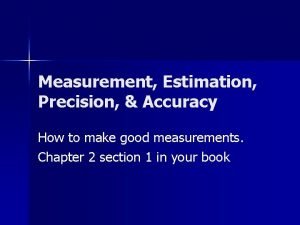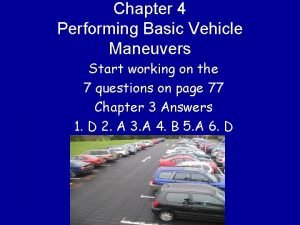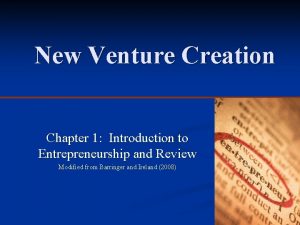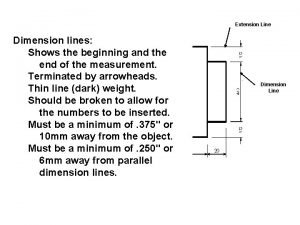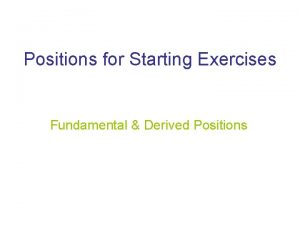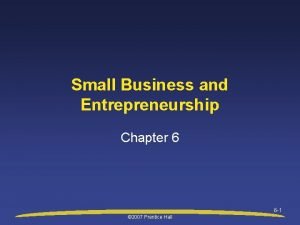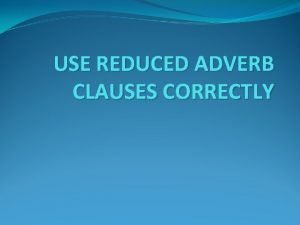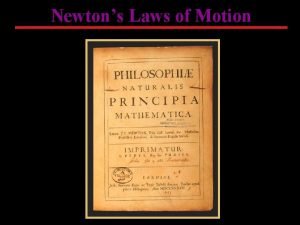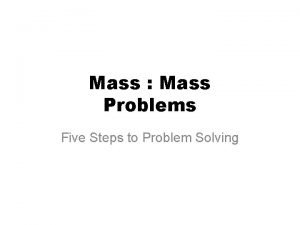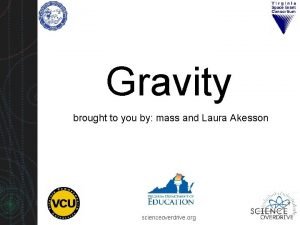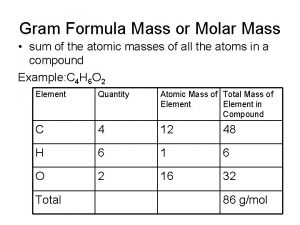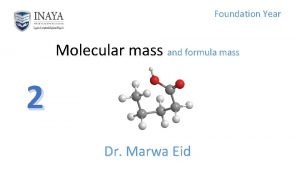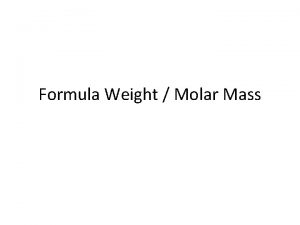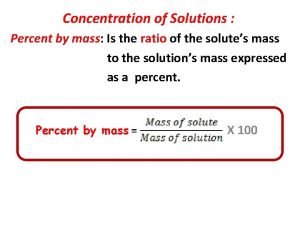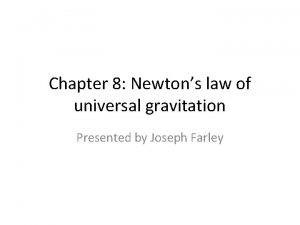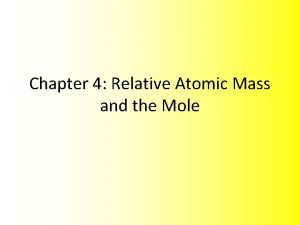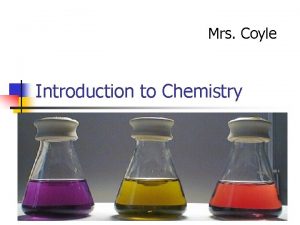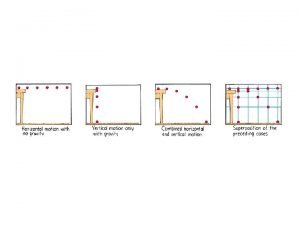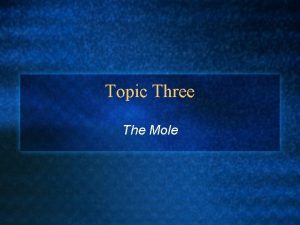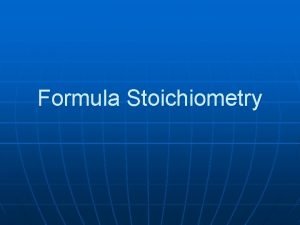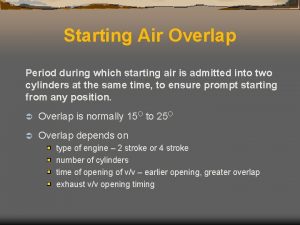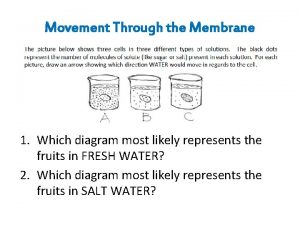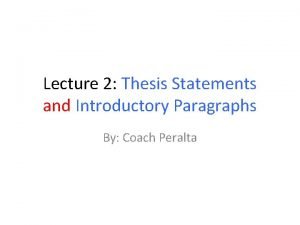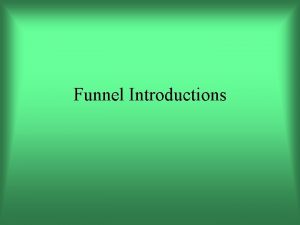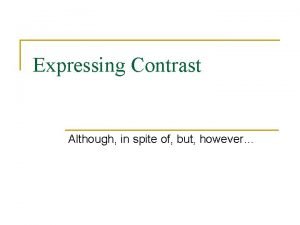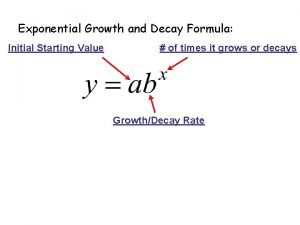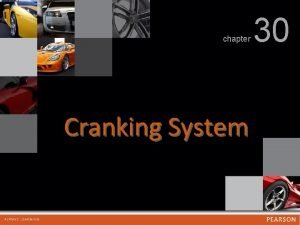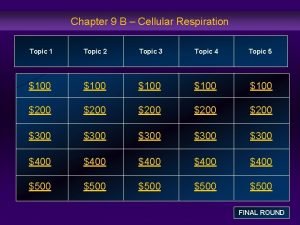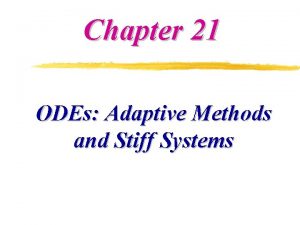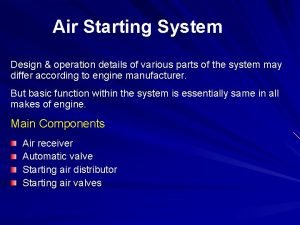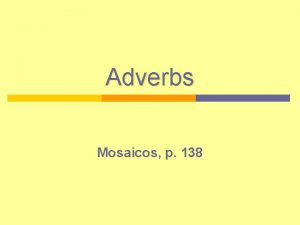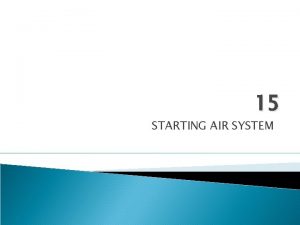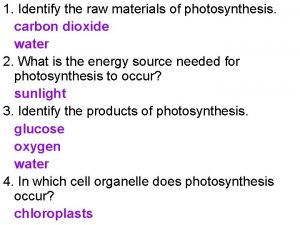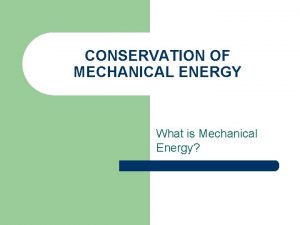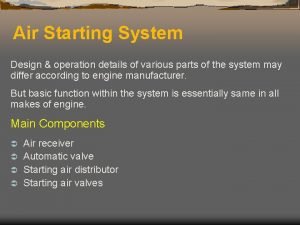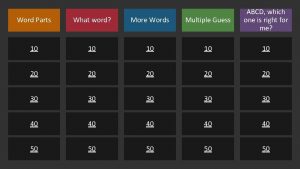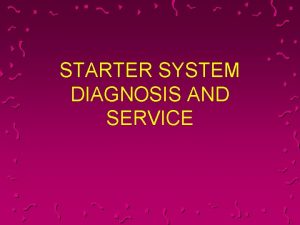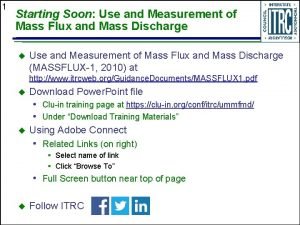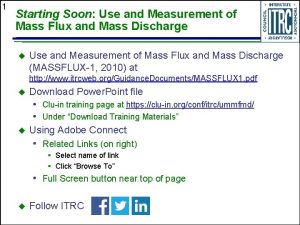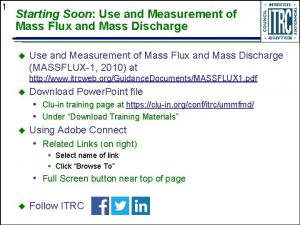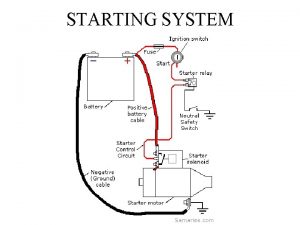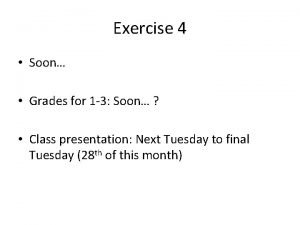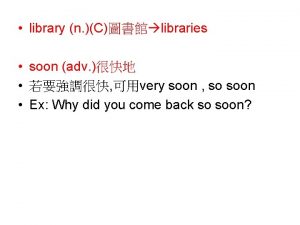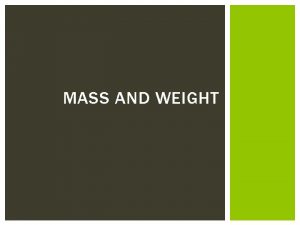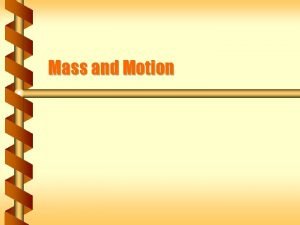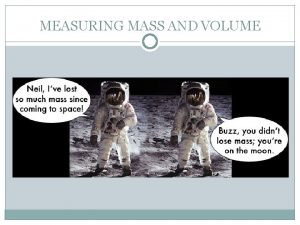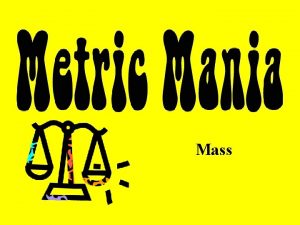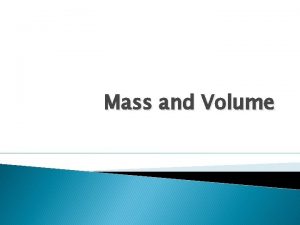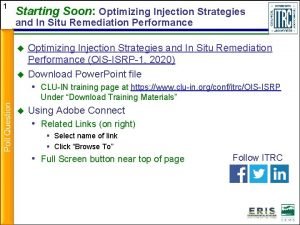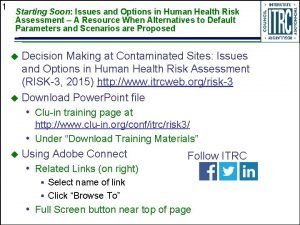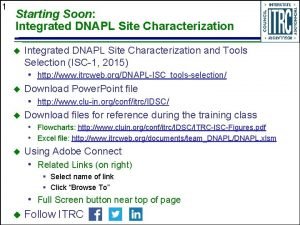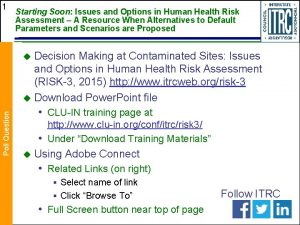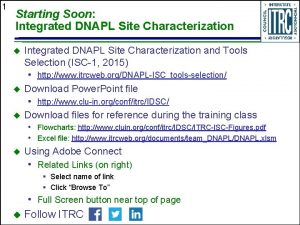1 Starting Soon Use and Measurement of Mass















































































- Slides: 79

1 Starting Soon: Use and Measurement of Mass Flux and Mass Discharge u Use and Measurement of Mass Flux and Mass Discharge (MASSFLUX-1, 2010) at http: //www. itrcweb. org/Guidance. Documents/MASSFLUX 1. pdf u u Download Power. Point file • Clu-in training page at https: //clu-in. org/conf/itrc/ummfmd/ • Under “Download Training Materials” Using Adobe Connect • Related Links (on right) § Select name of link § Click “Browse To” • Full Screen button near top of page u Follow ITRC

2 Welcome – Thanks for joining this ITRC Training Class Use and Measurement of Mass Flux and Mass Discharge An ITRC Technology Overview Document Sponsored by: Interstate Technology and Regulatory Council (www. itrcweb. org) Hosted by: US EPA Clean Up Information Network (www. cluin. org)

3 Housekeeping Course time is 2¼ hours u This event is being recorded u Trainers control slides • Want to control your u own slides? You can download presentation file on Clu-in training page u Questions and feedback • Throughout training: type in the “Q & A” box • At Q&A breaks: unmute your phone with #6 to ask out loud • At end of class: Feedback form available from last slide § Need confirmation of your participation today? Fill out the feedback form and check box for confirmation email and certificate Copyright 2016 Interstate Technology & Regulatory Council, 50 F Street, NW, Suite 350, Washington, DC 20001

4 ITRC (www. itrcweb. org) – Shaping the Future of Regulatory Acceptance u u u Host organization Network • State regulators Disclaimer • Full version in “Notes” section • Partially funded by the U. S. government § All 50 states, PR, DC § ITRC nor US government • Federal partners warranty material § ITRC nor US government DOE DOD endorse specific products EPA • ITRC materials copyrighted – • ITRC Industry Affiliates Program • Academia • Community stakeholders u Follow ITRC see usage policy u Available from www. itrcweb. org • Technical and regulatory guidance documents • Internet-based and classroom training schedule • More…

5 Meet the ITRC Trainers Alex Mac. Donald California Water Boards Rancho Cordova, CA 916 -464 -4625 amacdonald@ waterboards. ca. gov Tamzen Macbeth CDM Smith Helena, MT 208 -904 -0238 Macbethtw @cdmsmith. com Chuck Newell GSI Environmental Inc Houston, TX 713 -522 -6300 cjnewell@gsi-net. com Alec Naugle California Water Boards Oakland, CA 510 -622 -2510 anaugle@ waterboards. ca. gov Grant Carey Porewater Solutions Ontario, Canada 613 -270 -9458 gcarey@porewater. com

6 What You Will Learn… u u u u What is mass flux and mass discharge Why these are useful metrics How mass flux and discharge can complement concentrationbased measures What methods are available to measure mass flux and discharge How to calculate mass flux and discharge How existing site data may be used to estimate mass flux and discharge How to manage uncertainty Regulatory considerations with mass flux and discharge estimates

7 ITRC Mass Flux Project u u u Use and Measurement of Mass Flux and Mass Discharge (MASSFLUX-1, 2010) Other products • In Situ Bioremediation of Chlorinated Ethene: DNAPL Source Zones (Bio. DNAPL-3, 2008) • Integrated DNAPL Site Strategy (IDSS-1, 2011) www. itrcweb. org • Integrated DNAPL Site Characterization (coming soon) Integrated DNAPL Site Strategy Team University 5% Industry 50% Community Stakeholders States 3% 29% Federal Agencies 13%

8 ITRC Technology Overview u Use and Measurement of Mass Flux and Mass Discharge (ITRC MASSFLUX-1, 2010) • Concepts, measurement / estimation methods, and uses • Regulatory considerations • Case study review 1. Site characterization and CSM development 6. Site prioritization Mass Flux or 2. Potential impacts and exposure evaluation Mass Discharge 5. Compliance monitoring 3. Remediation selection and design 4. Performance monitoring and optimization Figure 1 -1

9 Regulatory Considerations Associated with Mass Flux and Mass Discharge u Precedent for use in a regulatory context • Federal Superfund § Signed Record of Decision (ROD) identifying a mass discharge interim goal was accepted in October 2009 • Surface water regulations § Total Maximum Daily Loads (TMDL) § National Pollutant Discharge Elimination System (NPDES) u Issues with regulatory acceptance • Complexity and uncertainty of mass flux measurements • How to relate mass flux to risk and exposure • Unclear how mass flux relates to standard regulatory metrics § e. g. , Maximum Contaminant Levels (MCLs)

10 Questions to Consider u u u Why should I estimate mass Mass Discharge (Md) = Sum of all flux/discharge at my site? Measures of Mass Flux x Area How do I calculate mass Md. B Source flux/discharge? What are the cost/benefits of using mass flux/ discharge? Can mass flux help measure compliance? Transect A Integrated DNAPL Site Strategy Transect B Tech-Reg Guidance (2011) further describes uses of mass JAij= Individual mass flux measurement at flux/discharge estimates Transect A Md. A= Mass discharge at transect A (sum of all of the mass discharge estimates for each specific area [Jaij x A])

11 Case Studies: Real Life Application of Case study from Mass Flux F. Payne, ARCADIS Prior plume interpretation 3 (a i m Plume interpretation with all data x) o r p p 2004 Plume response to remediation… 2008 2006. . and flux-informed decision making 201011

12 Course Roadmap Source u Mass concepts u Measurement methods u Application u Case studies u Summary Plume Transects Figure 2 -1

Mass Flux and Mass Discharge: Why Care? anding t s r e d n s! n o i t Better U u l o rter S a m S s d Yiel u u To augment concentrations, not replace them Allows targeted remediation strategies • Most flux is in a small fraction of the volume u Basis for existing groundwater models • Already used but often ignored u Plume Source Plume Provides meaningful performance metrics • Links partial treatment to risk reduction u Supply Well Source River 13 Recent advances in techniques Downgr adient R isk D to Mass Dischar ue g NOT Co ncentra e tion

14 Definitions u Mass Discharge (Md) = Sum of all Measures of Mass Flux x Area Mass discharge • The total mass of any solute conveyed by a plume at a given location • Md is a scalar quantity, expressed as mass/time u Mass flux • The rate of solute mass Md. B Source Transect A Transect B moving across a specific JAij= Individual mass flux measurement at defined area, usually a portion Transect A of the plume cross-section • Mass flux is a vector quantity, Md. A= Mass discharge at transect A (sum of expressed as mass/time/area all of the mass discharge estimates for each specific area [Jaij x A])

15 Mass Discharge: Source or Plume Strength Transects Well Source Q Plume Md } C=Concentration Across any Transect, a Contaminant Plume Conveys: Groundwater Discharge, Q (e. g. , L/day) Contaminant Mass Discharge, Md (e. g. , g/day or kg/year) Md = Q x C (L/day x mg/L = mg/day) Figure 2 -1

16 Mass Discharge and Concentration u Concentration-based approach may not account for important site characteristics • Large vs. small releases • Pumping rate at the receptor well Case A: Large Release High Max. Conc. and High Md KEY POINT: Case B: Small Release High Max. Conc. and Low Md Evaluation of mass discharge (Md) can increase understanding of site and be an important component of the site conceptual model

17 Mass Discharge vs. Traditional Approach u u Traditional Approach: Measure existing plume concentrations to assess • Impact on receptor wells • Natural attenuation rates • Remedial options Mass Discharge Approach: Define rate of mass discharge across specified crosssectional areas of plume to assess • Impact on receptor wells • Natural attenuation rates • Remedial options KEY BENEFITS: POE well Md = g/day POE well conc = ? Mass discharge approach sometimes offers a better understanding of potential risks and attenuation rates, and can lead to sounder remediation strategies. Mass discharge approach based on Einarson and Mackay (2001) ES&T, 35(3): 67 A-73 A

18 What Is Mass Flux? 1. Specific Discharge, q = K x i ( 2. Average concentration, Cavg 3. Mass Flux, (J ) = q x C L m 2/day ) (g/L) ( g m 2/day )

19 Mass Flux Can Be Highly Variable Isoconcentration Contours Transect Wells Flux Results Contaminant Concentration Highest Lowest Groundwater Flux Sampling Points Fast Figure 2 -4 Slow

20 Mass Flux and Concentration Figure 2 Mass Flux (J) = Ki. C Source Zone Fine Sand 3% Gravelly Sand 85% Sand 12% K = 1. 0 m/day i = 0. 003 m/m C = 10, 000 μg/L Mass Flux = 0. 03 g/day/m 2 K = 33. 3 m/day i = 0. 003 m/m C = 10, 000 μg/L Mass Flux = 1 g/day/m 2 K = 5. 0 m/day i = 0. 003 m/m C = 10, 000 μg/L Mass Flux = 0. 15 g/day/m 2

21 Interpolation Scale matters – what needs to be measured u How to interpolate between highly variable data u Most transects sample < 1% of the groundwater u

22 Mass Flux and Plume Evolution Diffusion into lower -K zones Early Phases – Plume Expanding Figure 2 -6 Expanding contaminant plume A Source Back-diffusion from lower-K zones Later Phases – Source Depleted Expanding clean water front B Source Depleted Mass flux transects Groundwater transport direction

23 Mass Flux and Mass Discharge Are Not New Concepts u u u Basis for source depletion and natural attenuation models Ex situ treatments based on loading rates (e. g. , Lb/hr) EPA, 2002: review of 20 pump and treat (P&T) sites • 35% of treatment systems to be replaced because mass loading estimates were inadequate C = 1000 Source C = 100 C = 10 Q Contaminant Loading = Q x C Extraction Wells

24 Uncertainty and its Management u Uncertainty inevitable, but manageable • Similar uncertainty with concentration data • To successfully establish compliance goals consensus between stakeholders required u Spatial heterogeneity and sample volumes • May need >> 1% (Li and Abriola, 2006) u Source / Plume Boundary? • Hard to find and hard to define u Solutions • Work Smart – Consider source architecture, plume evolution, hydrogeology, etc • Consider iterative investigation • Vertical variability is usually >> Lateral

25 Advantages and Limitations u Potential advantages • Improved conceptual site model (CSM) • More representative attenuation rates, exposure assessment • Improved remediation efficiency • Reduced remediation timeframe u Limitations • Uncertainty • Cost

26 Course Roadmap u Mass concepts u Measurement u Application u Case studies u Summary methods

27 Five Methods for Mass Discharge u Method 1: Transect Method (Sect. 4. 1) u Method 2: Well Capture/Pumping Methods (Sect. 4. 2) u Method 3: Passive Flux Meters (Sect. 4. 3) u Method 4: Using Existing Data (Isocontours) (Sect. 4. 4) u Method 5: Solute Transport Models (Sect. 4. 5) All methods are “ready to go” Source Strength Plume Strength

28 Calculating Mass Discharge: Transect Method Simple Example Nichols and Roth, 2004 Step-by-step approach assuming uniform groundwater velocity 1. Characterize plume (C) 2. Characterize flow (q) 3. Draw transect: with simple approach, just build crosssectional polygons (“window panes”) for each well across flow 4. Determine area (W • b = A) 5. Multiply and sum together: Md = Σ (Cn • An • q) Md = Mass discharge Cn = concentration in polygon n A n = Area of segment n W 4 < 0. 5 ug/L CROSS-SECTION W 3 W 2 W 1 45 ug/L b Polygon 1 74 ug/L < 0. 5 ug/L Polygon 2 Width

29 Calculating Mass Discharge: Groundwater Darcy Velocity Term (q) Md = Σ (Cn • An • qn) Calculation of Darcy Velocity q=K • i q = Groundwater Darcy velocity i = Hydraulic gradient K = Hydraulic conductivity* • Hydraulic conductivity can be determined by pumping test, slug test, or estimated based on soil type • Don’t use porosity – hydraulic calculations for groundwater (such as Theis equation) don’t rely on porosity Variability in groundwater velocity most applications of the transect method to date have assumed a uniform groundwater. Darcy velocity for the entire transect. However, different values for q may be used for different polygons if sufficient data are available.

30 Building Transects: General Rules u u Can be permanent or temporary installations No special well or sampling points needed Can be based on longer single screen wells or multilevel observations Transect must be perpendicular or close to perpendicular to groundwater flow Source Strength Plume Strength

31 Transect Method: Using High Resolution Data GW Flow Direction Nichols and Roth, 2004 u u Multi-level sampling means multiple level polygons Sum up all cells to get Mass Discharge (Md) in units of • Grams per day (g/dy) • or • Kilograms per year (kg/yr) Transect Figure 4 -1 In this case Md = 488 g/day w 1 (equal to 175 kg/year) This is “Mag 7 Plume” (Newell et al. , 2011) b 1 b 2 b 3 b 4 b 5 b 6 w 2 w 3 w 4 w 5

32 How Many Points? Depends on Use Information from Table 1. 1 Remedial Applications Mass Flux Data Use Relative Data Density Needed Estimate source strength Low Estimate plume stability High* Estimate mass balance-natural attenuation capacity Medium to High* Evaluate risk to receptor(s) Estimate risks and exposures at various points of potential exposure Low to Medium Select appropriate technology Determine remedial action objectives Active remediation or MNA Develop/optimize remedial design Evaluate remedial performance Evaluate compliance / LTM Determine appropriate remedial technology(ies) Low to High Evaluate heterogeneities in source architecture High Estimate source strength reductions necessary to transition technology (e. g. , in situ biorem. or MNA) Low Estimate distribution of contaminants High Compare actual mass removal to design. Compare electron acceptors to electron donors Determine mass discharge or flux limits to achieve remedial goals *If using multiple plume transects Low to High** Low to Medium **Depending on system design and treatment volume(s)

33 Use of Multiple Mass Transects Design Tailored to Site Conditions and Goals Transect 1 Transect 2 Transect 3 Source Zone Mass Discharge vs. Distance Mass Discharge vs. Time For more info see: “EPA’s Calculation and Use of First. Order Rate Constants – MNA” EPA/540/S-02/500

34 Two Related Concepts u Pre-characterization • One option is to use Membrane Interface Probes (MIPs) or some other screening tools to determine where mass discharge is located • Then design a mass discharge monitoring system with more focused sampling on high mass flux areas u Site characterization is different than long-term monitoring

35 Tools for Transect Method: High. Resolution Piezocone u u u High-resolution piezocone, MIP (Kram et al, 2008) Plus computational/visualization package (slices) Still experimental Shows mass flux in 2 or 3 dimensions Figure 4 -7

36 Tools for Transect Method: Calculator Lead author: Shahla Farhat, Ph. D. free at www. gsi-net. com Microsoft Excel-based

37 Key Features of Mass Flux Toolkit • Streamlines the data input process • You pick interpolation method • It does the calculations • Uncertainty/sensitivity analysis • Graphical output • How to use mass discharge data • Overall resource for mass flux

38

39 Method 1 – Transects Advantages and Limitations u Advantages • Commonly used – many applications • Direct measurement • Extension of accepted technology u Limitations • High resolution data can be costly • Calculations can be time consuming

40 Method 2 – Well Capture/Pump Tests Nichols and Roth, 2004 u Instead of plume flowing downgradient you capture the contaminant plume and measure flow, concentration on surface, but • Pumping should not Contaminant Source Dissolved Contaminant Plume Supply Well induce dissolution at the source • Pumping needs to reach steady state • High confidence that plume has been captured u Some pump and treat (P&T) systems can be ideal for Method 2 Groundwater Flow Line Capture Zone Md = Csw. Qsw Figure 4 -8

41 Well Capture Mass Discharge Calculation Nichols and Roth, 2004 Measure Q, Cwell from well Calculate mass discharge based on total capture of plume by pumping system Contaminant Source Groundwater Flow Line Dissolved Contaminant Plume Supply Well Md = Q x Cwell Md Figure 4 -8 Capture Zone = Mass discharge (grams per day) Cwell = concentration in recovery well effluent (grams per liter) Q = Well pumping rate (liters per day) gram x liters day = grams day

42 More Sophisticated Version Method 2 u Integral Pump Tests (IPT) • Steady state flow conditions, but handles changing heterogeneous concentrations in plume Pumping tests with concentration time series measurements Contaminated site Groundwater Flow Source Well 1 Well 2 of Pollutant Well 3 Isochrones (simplified) Concentration vs. time during pumping tests (compound specific) C Well 1 C Well 2 C Well 3 Contaminated plume Control plane Total contaminant mass flux and average concentration t 1 t 2 t 1 Transient inversion algorithm (analytical solution) Figure 4 -9. Estimating Mass Flux Using Integral Pump Test Series Data t 2

43 Well Capture Methods Advantages and Limitations u Advantages • Fewer wells • Better integration of flow and concentration data • Can use existing pumping system u Limitations • No mass flux data • Large volumes of water that need disposal/treatment • Possible to change plume characteristics • Difficult to assure full plume capture

44 Method 3 – Passive Flux Meter u Permeable sorbent • Accumulates contaminant based on flow and concentration u Soluble tracers • Loses tracer based on groundwater velocity and flux convergence calculations Source: Hatfield and Annable 1. Contaminant adsorbed onto passive flux meter over time to get Concentration Photo: Dye intercepted in a meter t 1 t 2 t 3 2. Tracer desorbs from passive flux meter over time to get Flow (Q) K 0 K>>K 0 Groundwater Flowlines

45 Passive Flux Meter Sampling Installation Vendor: http: //www. enviroflux. com/pfm. htm

46 Passive Flux Meter Advantages and Limitations u Advantages • • u “One stop shop” for both flow and concentration Easy to install in the field No waste generated Vendor available to implement this method Limitations • Some method-specific issues (lower measurement in pushed wells, slight biodegradation of tracer at one site, competitive sorption under some conditions) • Relies on well convergence calculations

47 Method 4 – Use Existing Data (Transect Based on Isocontours) u Uses existing well network and plume map u Combine with flow data Scale (ft) 1 2 5 10 N Transects 1 2 <0. 1 Concentration isopleths (mg/L) 3 Dover Air Force Base Delaware 1000 4 Two dimensional transect based on isocontour data <0. 1 Transect 1: Intersection with Contour Lines S-SW Concentration (mg/L) 0. 1 1 2 for contour lines Figure 4 -12 0 Geometric mean concentration (mg/L) between contour lines 5 10 15 10 0. 31 1. 4 3. 2 7. 1 12. 2 15 12. 2 1. 4 0. 31 5 7. 1 2 1 3. 2 N-NE 0. 1

48 Calculating Mass Discharge from Isocontours Single-Level Monitoring Well and Hypothetical Contaminant Concentration Plume Contour Data 1. 2. 3. Get isocontours from existing plume map Build transect using points where isocontours intersect transect line (you can add actual wells if close to contour) Apply Transect Method (Method 1) Calculations Nichols and Roth, 2004 3 2 Wi

49 Isocontour Method Advantages and Limitations u Advantages • Does not need special field study. Can use existing, historical data from existing monitoring system • Limited additional expense u Limitations • Wide range of opinion about usefulness of this method • Can be inaccurate if plume map is built with only a few wells. For example consider: § Gas station site with 5 wells throughout entire plume: not likely to provide high quality mass flux/mass discharge data versus § Well characterized site with 40 wells in source zone: likely to provide higher quality data

50 Measurement Method 5 – Computer Models u Using computer models odel M Models Integrate Flow and Concentration 1. Calibrate model 2. Get flow and concentration data across transect 3. Example Below from BIOSCREEN

51 REMChlor Model of Source Remediation Source: Ron Falta, Clemson Univ. Mass Discharge (Kg per year) Remove 90% of mass in 2010. REMchlor shows mass discharge vs. distance in future years 2008 2014 Distance from Source (meters) 2080

52 Measurement Method 5 Models with Mass Discharge Model application and type BIOSCREEN Fuel Hydrocarbon MNA, Analytical BIOCHLOR Chlorinated Solvent MNA, Analytical BIOBALANCE Chlorinated Solvent MNA, Analytical MODFLOW/MT 3 DMS General. Numerical MODFLOW/RT 3 DMS General, Sequential Degradation, Numerical MODFLOW/MT 3 D General. Numerical MODFLOW/RT 3 D - rt. Flux General. Numerical REMChlor Hydrocarbon, Chlorinated Solvent New! From Table 4 -3

53 Computer Model Method Advantages and Limitations u Advantages • Does not need special field study. Can use existing, historical data from existing monitoring system • Models are designed to combine flow, concentration data u Limitations • Helpful to have experience/training in using models • Need good data – both flow and concentration data • Amount of data depends on what information is being used for § For example - need absolute or relative number? § Table 1. 1 in Guide (shown under Transect Section) provides more detail

54 Five Methods for Mass Discharge u u u Method 1: Transect Method (Sect. 4. 1) • Commonly used. Based on familiar technology Method 2: Well Capture/Pumping Methods (Sect. 4. 2) • Many pump and treat systems doing this now. Method 3: Passive Flux Meters (Sect. 4. 3) • New technology, easy to install, one device for flow and concentration Method 4: Using Existing Data (Isocontours) (Sect. 4. 4) • Uses existing data. Cost effective, but requires good monitoring network. Method 5: Solute Transport Models (Sect. 4. 5) • Combines flow and concentration data. Helpful to have experience

55 Question and Answer Source u Mass concepts u Measurement methods Question and answer break u Application u Case studies u Summary Follow ITRC Plume Transects

56 Course Roadmap u Mass concepts u Measurement methods u Application u Case studies u Summary Figure 1 -1

57 Six Use Categories from Case Studies 1. Site Characterization 2. Potential Impacts and Exposure Evaluation 3. Remediation Selection and Design 4. Performance Monitoring and Optimization 5. Compliance Monitoring 6. Site Prioritization Ø Baseline mass discharge Ø Identify hotspots Ø Attenuation rates Ø Low vs. high K Ø Multiple sources Ø Remedial action objectives (RAOs) Ø Technology selection Ø Remedial design Ø Performance Ø Optimization

58 Increasing Use of Mass Flux and Mass Discharge Rapid increase in use since 1995 Number of Case Studies 1995 -99 2000 -04 2005 -09

0 n io Sit rit e iza tio Pr Po As Im ten se pa tial ss ct m en t Re m ed ia tio n Co M mp on li ito an rin ce g n tio ar S ac ite te riz a Ch 59 Over 61 Case Studies Documenting Mass Flux and Mass Discharge Use 40 30 Number of Case Studies 20 10

60 61 Where Mass Discharge Has Been Used Specific location (known city or county) Unspecified location within a state, province, or country

61 Reasons for Increased Use u New studies heterogeneous mass flux from source zones (e. g. Guilbeault et al. , 2005) u Improved monitoring techniques u Recent focus on improving remediation efficiency u New databases comparing technology performance based on source strength reduction

62 Frequency of Sites with VOC/SVOC Mass Discharge Ranges 18 16 14 12 Minimum = 0. 00029 kg/y Median = 10. 2 kg/y Maximum = 680 kg/y 36% 32% Geometric mean = 7. 7 kg/y Number 10 of Sites 8 6 11% 4 2 0 2% <0. 01 14% 5% 0% 0. 01 to 0. 1 100 to 10 to 0. 1 to 1000 1 10 Mass Discharge Interval (kg/y) >1000

63 Mass Discharge Calculations for Various Site Contaminant Mass Discharge (g/d) Reference Sampson County, NC MTBE 0. 6 - 2 (Borden et al, 1997) Vandenberg AFB, CA MTBE 4 -7 Unpublished Unnamed Site MTBE 4 Unpublished Elizabeth City, NC MTBE 7. 6 Wilson, 2000 St. Joseph, MI TCE 167 (Semprini et al, 1995) Dover AFB, DE CVOCs 630 (RTDF 1998) Table adapted from Einarson and Mackay (2001) ES&T, 35(3): 67 A-73 A

64 Using Mass Discharge: Estimating Well Impacts Einarson and Mackay, 2001 Use mass discharge of plume to predict constituent of concern concentration in downgradient water supply well Cwell = Md ÷ QWell Cwell = Concentration in extraction well Qwell = Pumping rate for extraction well 2 g/day x 1 600 gpm ÷ 1440 min x Clean water Md = 2 grams/day Clean water Extraction well Source zone Capture zone Qw = 600 gpm Clean water 1 gal 3. 79 L x 106 ug g = < 1 ug /L

65 Example: Prioritizing Treatment Zones As the source is depleted, more mass remains in less permeable regions. This preferential depletion may alter the priorities for remediation. Mass Flux (J) = Ki. C Residual Source Fine Sand 55% Gravelly Sand 18% Source Zone Fine Sand 3% Gravelly Sand 85% Sand 27% Sand 12% K = 1. 0 m/day i = 0. 003 m/m C = 5, 000 μg/L Mass Flux = 15 mg/d/m 2 K = 33. 3 m/day i = 0. 003 m/m C = 50 μg/L Mass Flux = 5 mg/d/m 2 K = 5. 0 m/day i = 0. 003 m/m C = 500 μg/L Mass Flux = 7. 5 mg/d/m 2

66 Mass Flux/Discharge Applications 1. Site Characterization 2. Potential Impacts and Exposure Evaluation u • Effect of natural attenuation u 5. Compliance Monitoring 6. Site Prioritization Quantifies • Potential impacts to 3. Remediation Selection and Design 4. Performance Monitoring and Optimization Shows wells and streams u Guides • Where remediation is needed ON-SITE OFF-SITE

67 Regulatory Precedence u u Federal Superfund…signed Record of Decision (ROD) identifying a mass discharge interim goal [Well 12 A site, WA, Oct 2009] Surface water regulation (e. g. , Total Maximum Daily Loads (TMDL), National Pollutant Discharge Elimination System (NPDES)) is based on mass discharge Groundwater extraction gives estimate of mass discharge over capture zone Natural attenuation relies on mass discharge reduction

68 Regulatory Acceptance – Needs 1. Develop comfort level with mass flux and mass discharge (Mf & Md) concepts, estimation methods, and uncertainties 2. Understand how mass discharge relates to riskbased concentration standards 3. Envision a future compliance role for Mf & Md: • To assess threat potential to receptors • To assess remedy performance • As a trigger for switching to MNA (or another remedy)

69 Course Roadmap u Mass concepts u Measurement methods u Application u Case studies u Summary

70 Frequency of Method Applications Mass Flux and Mass Discharge Measurement/Estimation Method No. Sites Where Applied Transects with groundwater sample collection 41 Integral Pump Test(s) 7 Transects with passive flux meters 5 Isoconcentration contours 2 Mass Balance 2 Solute Transport Model 1

71 Example No. 1 Characterization and CSM Alameda Naval Station, CA PZ-14 PZ-13 PZ-12 PZ-11 PZ-10 PZ-9 PZ-8 PZ-7 PZ-6 PZ-5 99% of Source Strength - 80% of mass in 7% of transect area - 90% of mass occurs where C > 20, 000 ug/L Data Source: Einarson and Mac. Kay, 2001 cis-1, 2 -DCE Concentration (ug/L) 100 1, 000 10, 000 20, 000 40, 000 100, 000 200, 000 Areal boundary used for mass discharge estimate

72 Example No. 2 – Mass Discharge (Md) as an Interim Remedial Goal Compliance Mass flux and mass discharge Focused Feasibility Study evaluation: Reduce source strength (Md) by 90%, MNA sufficient to achieve compliance ROD amendment: Multi -component remedyreduce source discharge Md by 90% & transition technology (if necessary) u Well 12 A Superfund Site, WA • Performance metric remedy Operational and Functional City Supply Well Plume Source Area

73 Example No. 3 – Site Prioritization Pumping Wells Potential Source Site Capture Zone 1. 2 Transect 1 1. 2 0. 5 Transect 2 2. 0 Md at pumping well (kg/year) Transects used to determine 2. 5 relative contribution of multiple source areas 0. 1 0. 7 0. 05 0. 2 Prioritize remedial efforts 0. 6 Transect 3 Scale (m) 0 300 Source: Bauer et al. , 2004

74 Mass Flux to Target Remediation: Case study from Reese Air Force Base F. Payne, ARCADIS Prior plume interpretation 3 (a i m Plume interpretation with all data x) o r p p 2004 Plume response to remediation… 2008 2006. . and flux-informed decision making 201074

75 Course Roadmap u Mass concepts u Measurement methods u Application u Case studies u Summary

76 Mass Flux and Mass Discharge Summary u Estimating mass may • Improve conceptual site models • Enhance remedial efficiency • Refinement of exposure assessment More effective site management u Can use historical data and existing monitoring networks in some cases u Can enhance compliance measurements u

77 Questions to Consider u u Why should I estimate mass Mass Discharge (Md) = Sum of all Measures of Mass Flux x Area flux/discharge at my site? • Characterization, exposure Md. B Source assessment, remedy selection, optimization, site prioritization, compliance How do I calculate mass flux/discharge? • Figure 2 -2 of the document Transect A What are the cost/benefits of Transect B using mass flux/discharge? • Life cycle cost reduction, JAij= Individual mass flux measurement at targeted remediation Transect A Can mass flux help measure Md. A= Mass discharge at transect A (sum of compliance? all of the mass discharge estimates • Mass reduction for each specific area [J x A]) aij

78 Additional ITRC Technical and Regulatory Guidance u u Integrated DNAPL Site Strategy (IDSS-1, 2011) • Further describe uses of mass flux and mass discharge estimates • Cleanup strategy • Goals and objectives • Treatment trains • Monitoring Integrated DNAPL Site Characterization (ISC-1, 2015) • DNAPL characteristics • Life cycle of a DNAPL site • Integrated site characterization § Plan § Tools selection § Implementation

79 Follow ITRC Thank You u Question and answer break u Links to additional resources • http: //www. clu-in. org/conf/itrc/ummfmd/resource. cfm u Feedback form – please complete • http: //www. clu-in. org/conf/itrc/ummfmd/feedback. cfm Need confirmation of your participation today? Fill out the feedback form and check box for confirmation email and certificate.
 Return of the king jesus
Return of the king jesus The si unit for measuring mass
The si unit for measuring mass Relative formula mass of hcl
Relative formula mass of hcl Differentiate between atomic number and mass number
Differentiate between atomic number and mass number How to calculate abundance of isotopes
How to calculate abundance of isotopes Atomic number mass
Atomic number mass What measurement does a graduated cylinder use
What measurement does a graduated cylinder use Performing basic maneuvers quiz
Performing basic maneuvers quiz Creating and starting the venture
Creating and starting the venture Extension line drawing
Extension line drawing Fundamental starting position
Fundamental starting position Chapter 6 entrepreneurship and starting a small business
Chapter 6 entrepreneurship and starting a small business Chapter 6 entrepreneurship and starting a small business
Chapter 6 entrepreneurship and starting a small business Entrepreneurship chapter 6
Entrepreneurship chapter 6 Derived position of lying
Derived position of lying Entrepreneurship and small business management chapter 6
Entrepreneurship and small business management chapter 6 Reduced adverb clauses
Reduced adverb clauses Stoichiometry ratio
Stoichiometry ratio How to calculate percent composition by mass
How to calculate percent composition by mass Inertial mass vs gravitational mass
Inertial mass vs gravitational mass Convert grams to moles
Convert grams to moles How to convert grams to mole
How to convert grams to mole Molar mass def
Molar mass def Mass to grams conversion
Mass to grams conversion Unit for molar mass
Unit for molar mass Mass/mass problems
Mass/mass problems Gravitational mass vs inertial mass
Gravitational mass vs inertial mass Molar mass table
Molar mass table Cl- molar mass
Cl- molar mass Atomicity of elements
Atomicity of elements Mass number formula
Mass number formula Percent by mass
Percent by mass Inertial mass vs gravitational mass
Inertial mass vs gravitational mass Co2 relative molecular mass
Co2 relative molecular mass Atomic mass vs molar mass
Atomic mass vs molar mass Stoichiometry worksheet #2 (mole-mass mass-mole problems)
Stoichiometry worksheet #2 (mole-mass mass-mole problems) N n avogadro
N n avogadro A rocket of mass 12000 kg accelerates vertically
A rocket of mass 12000 kg accelerates vertically Mass mole
Mass mole Formula mass vs gram formula mass
Formula mass vs gram formula mass Cold air mass overtakes warm air mass
Cold air mass overtakes warm air mass How you use ict today and how you will use it tomorrow
How you use ict today and how you will use it tomorrow Thinking of starting a business
Thinking of starting a business Character traits starting with n
Character traits starting with n Zahed siddique
Zahed siddique Three phase synchronous generator
Three phase synchronous generator Starting air overlap
Starting air overlap Presentation starting speech
Presentation starting speech Starting materials for cellular respiration
Starting materials for cellular respiration Tag essay example
Tag essay example Starting of introduction
Starting of introduction Official letter rules
Official letter rules Using however in a sentence with commas
Using however in a sentence with commas Exponential growth function
Exponential growth function Sturdt
Sturdt Chapter 30 engine starting systems
Chapter 30 engine starting systems Starting materials for cellular respiration
Starting materials for cellular respiration Heun method
Heun method There are three general types of franchising arrangements
There are three general types of franchising arrangements Checking account simulation
Checking account simulation Air start system
Air start system Adverb of frequency
Adverb of frequency Adjective with v
Adjective with v Main engine starting air system diagram
Main engine starting air system diagram Identify the process
Identify the process What is mechanical energy
What is mechanical energy The starting point in a presentation
The starting point in a presentation Radio waves microwaves song lyrics
Radio waves microwaves song lyrics 2 acrostic poems
2 acrostic poems Farm resort business plan
Farm resort business plan Nyx family tree
Nyx family tree Mechanical energy definition
Mechanical energy definition Hexagon agility test clockwise
Hexagon agility test clockwise Starting substances in a chemical reaction
Starting substances in a chemical reaction Synchronous motor hunting
Synchronous motor hunting Starting air distributor diagram
Starting air distributor diagram _____ is difficulty in starting a urinary stream.
_____ is difficulty in starting a urinary stream. Components of starting system
Components of starting system Robert pushes the box to the left
Robert pushes the box to the left Primitive fire starting
Primitive fire starting






